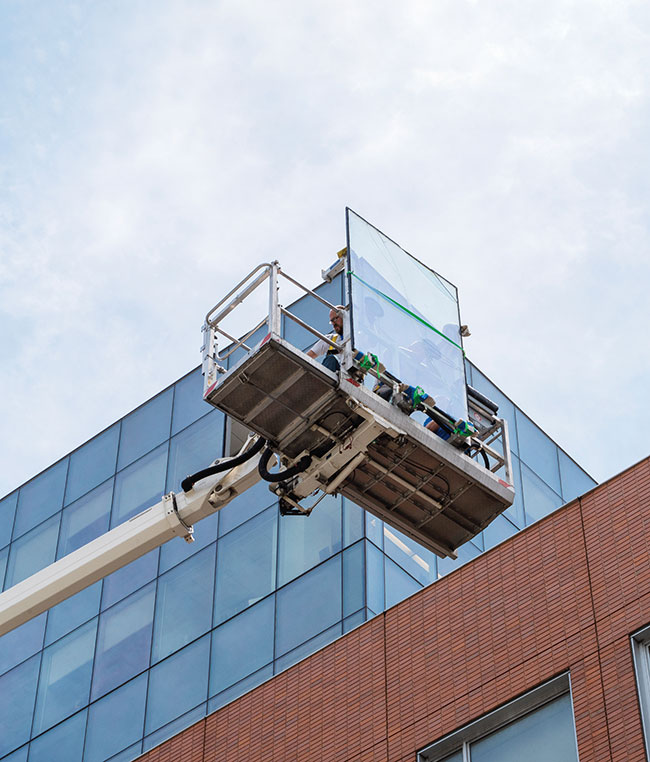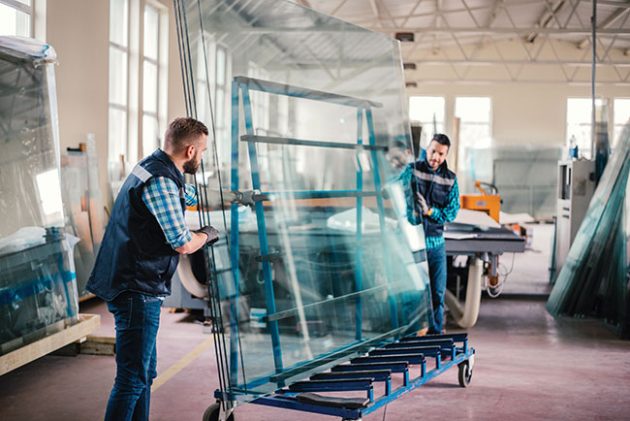
Features
Business intelligence
Glass
Supply Pain
The glass industry is functioning well despite supply chain disruptions.
December 3, 2020 By Sukanya Ray Ghosh
 The glass industry has been faring well over all despite the impact on supply chain due to the pandemic. Photo credit: © Alex Potemkin / E+ / Getty Images
The glass industry has been faring well over all despite the impact on supply chain due to the pandemic. Photo credit: © Alex Potemkin / E+ / Getty Images The spring of 2020 will always be remembered for how an unwelcome guest, COVID-19, entered our lives and turned the whole world upside down. The disruptions in our lives have been extreme, but we have all learned to survive. Keeping the economy up and running has been a challenging task. However, a major factor driving the stories for every industry is how well the supply chain has held up. It is no different for the construction industry in Canada.
Getting what is needed
Even when the pandemic is wreaking havoc in everyone’s lives in equal measure, the story of every business and every industry is a little different from the other. With the world being a global economy today, it is interesting to understand how the supply chain functions in each market. Does having mostly local suppliers help? How well has having international suppliers worked out? How much has COVID-19 slowed things down? These are just some of the questions that come to mind.
According to Ted Redlarski from Noram Glass, things have been getting slower since the onset of the pandemic. “We are able to get the products that we need but it takes longer to get it than it would have in normal circumstances,” he says.
Redlarski notes that besides seeing a slowdown in the marketplace there has been a noticeable impact on the capacity.
“Somehow, for a variety of reasons, the capacity has reduced. One of the reasons for this is it is taking longer to get approvals because people are working from home now more often,” he says.
He further adds that most of the businesses that were able to provide the products at 100 percent capacity are not able to do so anymore because of the many restrictions that have been put in place. Therefore, the suppliers are going slower even though they might not necessarily have less orders. As a result of this, there is less work around because some products may have been put on hold. All the companies that are open and are doing business are certainly experiencing bottlenecks in the flow of their productivity.
Most glass operations have been faring quite well when compared to many other industries. While the market has indeed slowed down, it is still functioning quite healthily.
For Jim Brady of Cal-Tech Glass Services, the supply chain disruptions have not had too big an impact. “Regular glass has not been affected at all by COVID-19,” he says. “However, specialty hardware has had an extra week or so added to lead times. One aluminum extrusion supplier has had issues because of company policies related to COVID-19 which has made it difficult for us when dealing with them. Aluminum extrusions from other suppliers has not been affected by COVID-19. Clear, standard low-Es, greys, have not been affected. But some specialty glass has been affected, such as pinhead.”
Andrew Dolphin, general manager of glass operations at BVGlazing Systems, has a fairly similar story to tell. “Just recently, we were facing some issues with silicone. So, we had to increase our stock of the product. There was a spacer bar issue but that was more to do with a strike at a Montreal port than COVID-19 really,” he says.
Dolphin adds that glass mostly comes in from the U.S., even though some companies do purchase from overseas. “I mostly just buy my glass from the U.S. companies. And that has gone on as it normally would. Products have been flowing through. I haven’t really seen much disruption on my end. It really hasn’t been too bad.”
Even with the positive trends in the market, not all companies have had the fortune of remaining unaffected. As witnessed by Laura Weil, vice-president of sales at Euro Vinyl Windows and Doors, there have certainly been hiccups along the way. The company’s original glass supplier, in Indiana, partially shut down due to rising COVID-19 cases. Now its local supplier has issued a notice that it has temporarily shut down operations. Updating its customers about the situation, the supplier has stated that one of its employees is being tested for possible exposure. The notice further adds that all employees that have had close personal contact with this person have been asked to stay home and self-monitor their health.
The supplier in this situation has taken the right step towards ensuring everyone’s safety. However, it does add a dent to the business of those customers that are relying more on local suppliers to keep themselves afloat.

Going local might help you retain control over your supply chain as the COVID-19 situation evolves. Photo credit: © bluecinema / E+ / Getty Images
The impact on projects
With supply chain issues come disruptions to the normal work flow of projects. However, at Cal-Tech Glass Services, there have been no real issues, says Brady. The lead times on all projects have basically remained the same as before.
“One glass supplier did have an outbreak of COVID-19 and it slowed things down for about three weeks but they have since recovered,” he says.
Redlarski on the other hand has been feeling the effects of the slower supply times of today. “The entire process, from design to completion of projects, has slowed down for sure. What was initially planned at length before typically slides further back. I would say it differs from project to project,” he says. He adds that the slowdown is big enough to be visible but he wouldn’t call it disastrous. The various restrictions in place are affecting the lead times on bringing out products and consequently their supply. The backlogs did not really increase; instead the efficiency has decreased, Redlarski notes.
Dolphin, who is a glass fabricator, says that the glazing contractors and the mid-level glazing contractors are more under the gun due to the supply chain issues. This is more so because they were not deemed essential. “Their site went down as a result. They’re now trying to squeeze eight months of work into six months. This has caused a lot of high lead times from the fabricators to the glazing contractors.”
The road ahead
Overall, the glass industry’s performance so far suggests that it might not be too tough to overcome the current challenges.
Redlarski notes that despite the supply disruptions, the industry has been able to function at anywhere between 80 to 90 percent capacity. Even though work is not progressing full speed ahead, it has not been a massive setback. He believes that once the situation improves and all the restrictions removed, everyone will begin trying to achieve full capacity.
Redlarski’s suppliers remain vocally optimistic but there seems to be an underlying uncertainty since the situation does not have any recent templates to follow. “They’re hoping for the best. But many people have the fear that the worst is yet to come. I sense that uncertainty especially when people talk about plans going forward.”
On a related note, Redlarski is seeing people in the industry turning more and more to local suppliers rather than out-of-town suppliers. The reason, he says, is it makes for a more stable environment. Everyone in the area is affected in the same way and are following the same rules. “If you are dealing with suppliers from Europe, for example, and they have lockdowns, you might face turbulence if your business is ongoing. With local suppliers, you can negotiate something to make things work,” he explains.
Brady’s suppliers have even indicated that a glass increase of seven to 12 percent is forthcoming. For him, the supply side of things has been running just as it was before. The only difference and downside of the current situation is that it is not possible to socialize with the suppliers any more.
However, Brady adds that the biggest issue facing the glass industry now is panic pricing. “Companies are fearing a lack of work and are therefore bidding jobs with very small margins. We need to resist the urge to panic,” he cautions.
On the fabricator side of things, a lot of Dolphin’s suppliers are cautiously optimistic that things are going to turn out okay going forward. “The high-rise residential market seems to be going on as normal. The commercial market is looking to be a little bit more impacted by what’s happening,” he says.
Dolphin notes that even without COVID-19, a slowdown was bound to happen at some point. The glass industry has been in a 10-year growth period anyway, so the slowdown was due.
Dolphin adds that from his perspective, the supply chain has held quite well in the glass industry across Canada. At this point, the restrictions have caused a time crunch instead of a product crunch. “We’ve been really lucky that there hasn’t been too much stress on the supply chain from a glass fabricators point of view,” he says.
Print this page
Leave a Reply